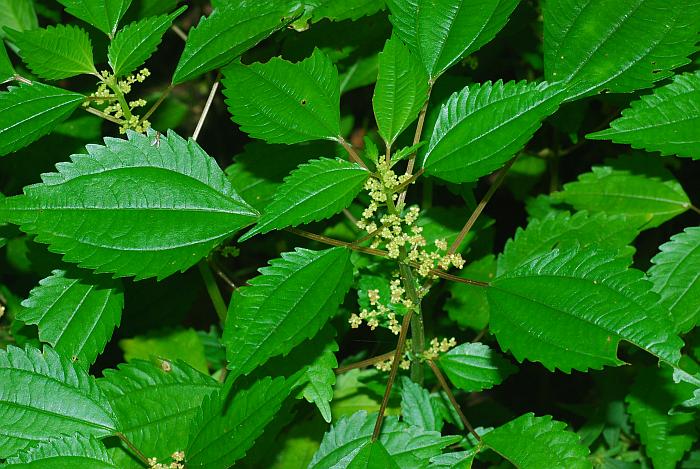Pilea pumila (L.) A. Gray
Clearweed

Native
CC = 4
CW = -3
MOC = 68
© SRTurner
Pilea pumila (L.) A. GrayClearweed | |
 |
Native CC = 4 CW = -3 MOC = 68 |
© SRTurner |
|
Family - Urticaceae Habit - Annual taprooted forb, monoecious or dioecious, unarmed, glabrous, the stems and leaf petioles translucent. Stem - To 50 cm, erect or ascending, occasionally from a spreading base, usually unbranched, stout, glabrous, translucent, and slightly succulent.
Leaves - Opposite, long-petiolate, stipulate. Blades 2-12 cm long, elliptic to ovate, glossy adaxially, broadly angled to rounded at the base, tapered at the tip, the margins bluntly toothed to nearly scalloped or occasionally sharply toothed, with 3 main veins; cystoliths linear.
Inflorescence - Small axillary clusters, these often arranged into small panicles, the staminate and pistillate flowers usually on different branches of the same panicle. Bractlets not forming an involucre. Flowers - Staminate flowers with 4 sepals, these 0.7-1.1 mm long, loosely cupped around the stamens. Stamens 4. Pistillate flowers with 3 free sepals, these 0.8-1.2 mm long, equal or occasionally 1 somewhat enlarged and hoodlike. Style absent, the stigma capitate, not persistent at fruiting.
Fruits - 1.3-1.8 mm long, flattened, ovate in outline, the surfaces smooth, green or straw-colored, sometimes with purplish streaks.
Flowering - July - October. Habitat - Bottomland forests, margins of streams, ponds, lakes and sloughs, moist disturbed soils. Origin - Native to the U.S. Lookalikes - Pilea fontana; more broadly, other members of the Urticaceae such as Urtica dioica and Boehmeria cylindrica; also Acalypha rhomboidea. Other info. - This small species occurs throughout Missouri and is quite common in the listed habitats. Its range extends across the eastern half of the continental U.S. and into Canada. Photographs taken in Weldon Spring Conservation Area, St. Charles County, MO, 8-15-2010, and along the Katy Trail northwest of Dutzow, Warren County, MO, 9-4-2015 and 8-4-2024 (SRTurner). |